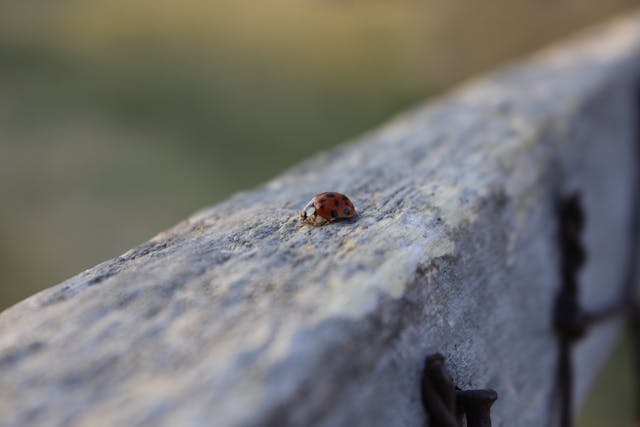Ladybugs are often seen as cute and harmless, but when you start seeing them everywhere—especially in the middle of winter—you might wonder, “Why are there so many ladybugs?”
While beneficial in small numbers, these colorful insects can become quite a nuisance when they gather in swarms. So, what’s the deal with all these ladybugs, and why do they show up in droves when the weather turns cold?
Let’s dive into the reasons behind these ladybug invasions and why winter is their time to shine.
Why Are There So Many Ladybugs?

First, if you see an unusual number of ladybugs, you’re not imagining things. There are a few reasons why these little beetles can suddenly seem to take over:
Ladybug Boom
Ladybugs, specifically the Asian lady beetle variety, are incredibly efficient at reproducing. During the warmer months, they feast on aphids and other plant-damaging pests, helping them multiply quickly.
A single ladybug can lay hundreds of eggs, and their population can skyrocket if conditions are just right—lots of food, mild temperatures, and plenty of space to breed.
The thing is, ladybugs aren’t shy about moving into new territories. If you live near agricultural fields, forests, or gardens, you’re more likely to see swarms of them looking for food and places to lay their eggs. This explosion in numbers is one big reason why you suddenly find yourself surrounded by these spotted critters.
Invasive Species
While we might think of ladybugs as native insects, the influx you’re experiencing could actually be the Asian lady beetle, a species introduced to the U.S. to control aphid populations.
The problem? They’ve thrived so well that they’ve become invasive in many parts of the country. These ladybugs are particularly aggressive and more likely to show up in large numbers—way more than the quaint, solitary ladybugs you remember from childhood.
Seasonal Behavior
In the fall, ladybugs prepare for winter by searching for warm places to hunker down. They don’t die off when the cold weather hits—instead, they enter a form of hibernation called diapause. This survival tactic is key to why there are so many ladybugs, as they cluster together to conserve warmth and energy.
Why Are There So Many Ladybugs During the Winter?

Now, onto the million-dollar question: Why are there so many ladybugs during the winter? Isn’t this the time when most insects disappear? Not for ladybugs!
Seeking Warmth
As the temperatures drop, ladybugs look for a warm place to ride out the winter months. And unfortunately, your cozy home could be their top destination. They’re drawn to the warmth of buildings and homes, sneaking inside through cracks, windows, or under doors. Once inside, they gather in groups, usually in attics, wall voids, or other hidden spaces where they can stay undisturbed until spring.
This is why you might suddenly see a surge of ladybugs swarming around windows or light fixtures during the colder months. They’re not active during winter in the traditional sense, but any warmth, like sunlight hitting a window, can wake them up from their hibernation. That’s why so many seem to come out of the woodwork in winter when the sun peeks out.
Cluster Behavior
Ladybugs are social insects, and they have a unique habit called “overwintering,” where they gather in large groups to survive the winter. These clusters help them conserve warmth and moisture, ensuring they make it through to spring. This means if you see one or two ladybugs in your home during the winter, there’s a good chance a whole group isn’t far behind.
Indoor Invasions
You might wonder why ladybugs end up in your home rather than staying outside where they belong. It’s simple: to them, your home offers everything they need to survive the winter. Ladybugs are attracted to light-colored buildings, especially those facing south or west, where the sun’s warmth is strongest.
Once they find a way in, whether through a crack in the foundation, an open window, or a gap around a door, they’ll settle in and cluster in large numbers. While they don’t cause structural damage or spread disease, having hundreds of ladybugs crawling around your home can quickly become a headache.
How to Prevent a Ladybug Invasion
Now that we’ve answered why there are so many ladybugs and why they’re especially common during winter, let’s talk about prevention. It’s important to act before they take over your space:
- Seal Entry Points: Ladybugs are small, so even the tiniest gaps can be an invitation. Check your home for any cracks, crevices, or openings, and seal them up to keep ladybugs from sneaking inside.
- Install Screens: Make sure windows and doors are properly screened, and fix any holes or tears in your screens.
- Use Weatherstripping: Install weatherstripping around doors and windows to create a tighter seal and block ladybug entry points.
- Keep Outdoor Lights Off: Ladybugs are drawn to light. Turning off outdoor lights or using yellow “bug” lights can reduce the number of ladybugs flocking to your home.
- Call in the Pros: If ladybugs have already taken over, professional pest control services can help. Getting rid of an infestation is easier when you leave it to the experts.
Why Dealing with Ladybugs Matters

You might think, “Ladybugs are harmless—why bother getting rid of them?” While it’s true that ladybugs don’t bite or damage property, having them around in large numbers can be frustrating.
Their presence can lead to stains on walls, furniture, and fabrics. When stressed, they release a yellowish fluid that has a strong, unpleasant odor that can be difficult to remove.
Plus, they don’t always stay hidden! On warmer winter days, you might find them crawling all over your walls, windows, and light fixtures, certainly not the peaceful winter retreat you had in mind.
Don’t Let Ladybugs Take Over
If you’re tired of seeing these spotted invaders, you’re not alone. When ladybugs invade, they can quickly become a nuisance, especially when they cluster inside your home during winter. That’s where proof. Pest Control comes in. Our team of experts knows how to handle these seasonal invasions, ensuring that your home stays ladybug-free, no matter the time of year.
Get in touch with us today, and we’ll help keep your home pest-free, winter or summer!

